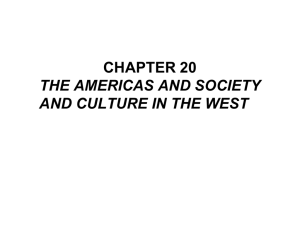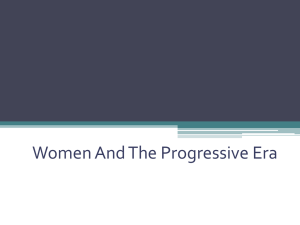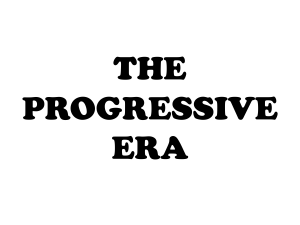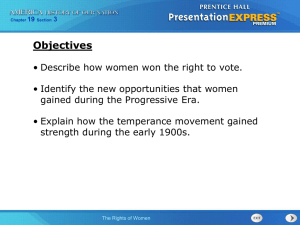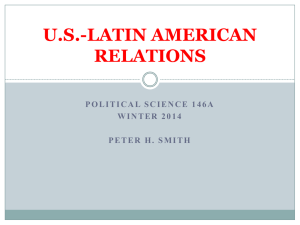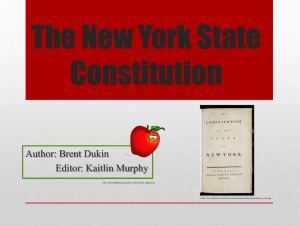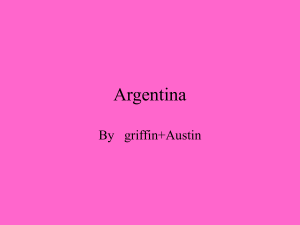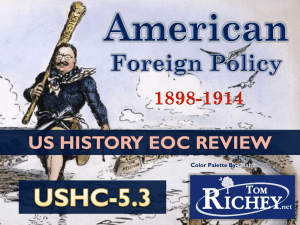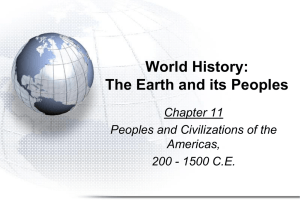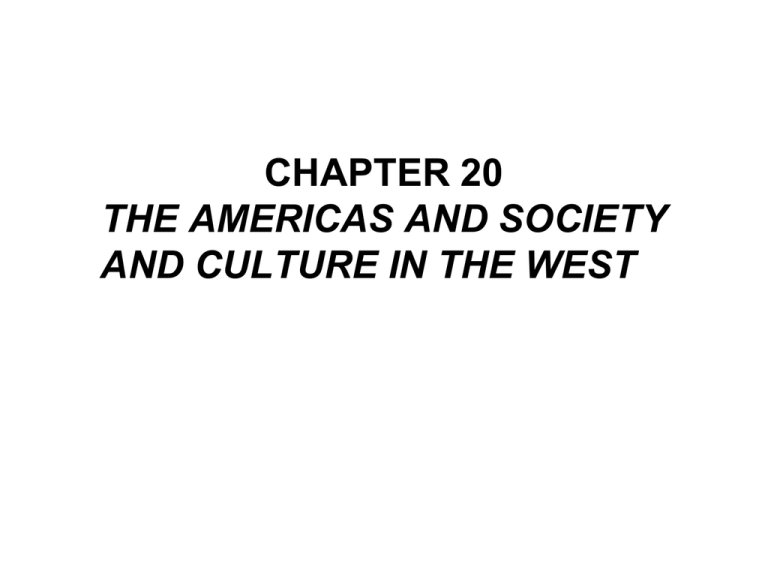
CHAPTER 20
THE AMERICAS AND SOCIETY
AND CULTURE IN THE WEST
Latin America: 19th & early 20th C
• Q: What role did liberalism and
nationalism play in Latin America Between
1800 and 1870?
• Q: What were the major economic, social
and political trends in Latin American in
the late 19th and early 20th Centuries.
Challenge to Spanish &
Portuguese Colonialism
• Influence of Enlightenment ideals &
upheavals in the Napoleonic era
– The Wars for Independence
• Creole Elites: descendants of Europeans
• Simon Bolivar of Venezuela
• Jose de San Martin of Argentina
– Principle of Equality of all people under law
– Free trade
– Free press
» Did not apply to everyone
Toussaint L’Ouverture,Haiti,
1804
© North Wind Picture Archives
Nationalistic Revolts
• Mexican Independence, 1810
– Miguel Hidalgo Y Costilla
– Represented a peoples revolution
• September 16, 1910 crushed
• Creoles & Peninsulars united to defeat the
popular revolution
– Augustin de Iturbide, first emperor of Mexico,
1821
• No political or economic changes
“Liberator” of
South America
•Bolý´var leading
his troops across
the Andes in 1823
to fight in Peru
© SuperStock
Simon Bolivar, Venezuela
• Creole elite
• Influenced by enlightenment ideals
• Led “liberation” movements all over
Northern South America
– Venezuela independence, 1813
– First president by 1819
– Colombia
– Ecuador
– Peru
“Liberators” of
South America
•Theodore
Ge´ricault,
•French Romantic
painter,
•San Martý´n is
shown leading his
troops at the
Battle of
Chacabuco in
Chile in 1817.
Jose de San Martin, Argentina
• Son of a Spanish army officer in Argentina
• served in the Spanish military
• Returned to Argentina in 1812 to a newly
independent Argentina.
– He believed Complete removal of Spaniards
if any nation was to be free.
• his military leaders, Bernardo O’Higgins
was made supreme dictator of Chile in
1817
By1824:
Free
states:
Uruguay,
Paraguay,
Colombia,
Venezuela,
Argentina,
Bolivia
Chile
• Latin America in the First Half of the
Nineteenth Century
Monroe Doctrine
• Britain, sought Spheres of Influence in
Latin America
– access for investment and trade
– proposed joint action with the U.S. to exclude
other European influence
• James Monroe,1823, “guaranteed
independence” of Latin America
– warning against further European influence,
– British navy ensured military might
• American/British sphere of influence
Nation Building
• The Difficulties of Nation Building
(1830-187))
– European intervention
– Consequences of Wars for independence
• Loss of population, property and livestock
• Boundary disputes
• Poor transportation and communication
challenged unity and fostered regionalism
Political Obstacles
• Different types of leadership
• Caudillos (leaders) of New Republics
– National Caudillos
• Autocrats: Supported elites and controlled
state revenues, favored centralized power and
unity of states
– worked against the majority’s interests
– Sometimes were modernizers in that they build
infrastructure, canal, ports, schools,
Autocrats
• Caudillos
– Often supported by the Church, Aristocracy,
military
– Often former military leaders
• Destructive leadership
–
–
–
–
–
Antonio Lopez de Santa Ana of Mexico
1829 – 1855 ruled
Misused state funds
Curtailed reforms
Lost territory to the U.S.
Popular Caudillos
• Supported by the masses
– Served as an instrument for change
• Juan Manuel de Rosas, Argentina, 1829 – 1852
– Favored Argentine interests against Foriegners
• Rafael Carrera, Guatamala, 1839 - 1865
– Indigenous advocate
– Pursued policy of land redistribution
– Reversed by Justo Rufino Barrios – pushed economy to
coffee production and wage laborers
Economic Patterns
• Great Britain & America dominated Latin
American economy
– British merchants and investors
• Mining industry
• Exploited raw materials
• Created a market for manufactured goods
Social Conditions
• Incredible disparity of wealth
– Landed elite
• Land basis of wealth, social prestige, political power
• Controlled government, courts
• Maintained system of debt peonage
– Post independence – size of estates expanded
• Sanchez Navarro Family by 1848 in Mexico
– 17 Haciendas over 16 million acres
• Argentina, 5 families bought 21 million acres of public
lands
Latin America after 1870
• Rapid economic growth
• Export items (Raw Materials)
– Argentina: Wheat and Beef
– Brazil: Coffee
– Chili: Nitrates
– Central America: Coffee and bananas
– Peru: silver and sugar
Foreign Investments
• 1870 – 1913 foreign investments boomed
– British investment:
• Growth from 85 to 757 million pound, 2/3 of all
foreign investments
– Railroads
– Mining
– Public utilities
• Slavery technically abolished in 1888
• Most people remained subservient and
dependent on elite and foriegners
Further Class Stratification
• Social and political repercussions of the
development of an export economy
– Modernization of elites
• Profit motive and greater exploitation of workers
– Growth of an upper crust
• New prosperity for 5-10% of the population
• Lawyers, merchants, shopkeepers, businessmen,
school teachers, professors, bureaucrats, military
officers
– sought liberal reform, not revolution, elites ameliorated
their impulse by extending suffrage.
Catholic Church
• Enormous land holdings-Exercised great
power
• Clerics took position in new governments
following independence
– Considerable influence
• Conflict of church & state
– Liberals wanted to curtail powers of church
– Conservatives hoped to maintain privileges
and power of church
Working Class
• Growth of labor unions
– Radical unions advocated use of the general
strike as an instrument for change
• Lack of suffrage hampered political
change
Political Change after 1870
• Landed Elite
– took more direct interest in national politics.
• Argentina and Chile
– Controlled government
– produced constitutions similar to those of the
US and Europe
– limited suffrage maintained concentration of
power
Dictators
• Some landowners made use of dictators to
maintain the interests of the ruling elite.
– Porfirio Diaz , Mexico, Ruled 1876 – 1910,
• established a conservative, centralized government
– support of the army, foreign capitalists, large
landowners, and the catholic church.
• Consequences of Dictatorship:
– real wages of working class declined,
– 95% of rural population owned no land,
– 1000 families owned the land.
Economy after 1870
• Growth of economy
– Modernization & wealth a veneer
– Enjoyed by the wealthy minority
• Rural elites dominated workers
– Indians impoverished
– Debt servitude
– Dependent on foreigners
Emiliano Zapata
•Liberal landowner
Francisco Madero,
forced Diaz from
power
•Madera’s
ineffectiveness to
carry out sufficient
reform triggered a
demand for agrarian
reform led by Zapata
© Snark/Art Resource, NY
Mexican Revolution, 1910
• He aroused the revolutionary impulse of
landless
– Seized the haciendas (plantations) of the
wealthy
• Impact of revolution
– destroyed the economy
– new constitution in 1917
Mexico’s New Constitution
• New Constitution, 1917
• established a strong presidency,
• initiated land reform policies,
• established limits on foreign investors,
• set an agenda for social welfare of workers.
• The nationalistic fervor also took an
indigenous tone rather than a celebration of
European heritage or influence.
United States Intervention
• United States emergence as a world power
– interfered into the economies of Latin America
• The Spanish American War 1898
– U.S. gained Cuba as a protectorate,
– Annexed Puerto Rico
• Between 1898 – 1934
– sent military forces to Cuba, Mexico,
Guatamala, Honduras, Nicaragua, Panama,
Columbia, Haiti, and the Dominica Republic
Cuba
• 1901 Platt Amendment
• Conditions for Cuban independence
– could not make treaties with foreign powers
– US would maintain broad authority to intervene in
economic and political affairs
– had to sell or lease lands to US for Naval Stations
• US invested heavily there and intervened in
political and economic affairs to protect those
investments and reap the wealth (5x 19061921)
Puerto Rico
Annexed under the Foraker Act 1900
– “unincorporated territory”
• no citizenship
• congress would dictate the government and
specify the rights of inhabitants throughout the
20th century
• Large scale sugar production by U.S. business
• Theodore Roosevelt Jr.
– Under domination of US capital “poverty was wide
spread and hunger, almost to the verge of starvation ,
common”
Imperialist Arguments
• Taking Philippines
– boost US trade w/ China
• Competition w
/other Empires
• “white man’s burden”
• Take up the White
Man's burden-Send forth the best ye
breed-Go, bind your sons to
exile
To serve your captives'
need;
To wait, in heavy
harness,
On fluttered folk and
wild-Your new-caught sullen
peoples,
Half devil and half
child..."
• Rudyard Kipling McClure's Magazine
12 (Feb. 1899).
United States & Canada
• Q: What role did nationalism and
liberalism play in the United States and
Canada between 1800 an 1870?
• What Economic, social and political trends
were evident in the United States and
Canada between 1870 – 1914?
Who would Rule America?
• Elitists or conservatives– later the Federalists
• Constituency: Wealthier, better educated
• Residents of Urban areas, commercially oriented towns,
agricultural districts
• Franchise limited to property holders/wealthy elite
– Maintain power and wealth of the elite
• The Democrats or Radicals– later the
Democratic Republicans or Anti-Federalists
• Constituency: Small farmers who predominated in America
• Believed common man capable of self-government
– The essential task of government was to preserve the liberties
of the people from greed and corruption of those who wielded
power
Crisis of the 1780s
• Post Colonial War Depression
– 60% increase in land taxes to pay for costs of war
• Rose between 1783-1786
– Crop Failures
– Local courts began seizing property
• Lost farms, debtor prison
• Political Protests,
– Mass. Farmers Demanded for tax relief
– Shaysites first petitioned state government, provided no relief
– 1000 farmers shut down the county court in North Hampton
• Popular mandate citizens would no longer permit judges to seize property or
condemn them to prison
– August 29, 1786, Revolutionary veteran, Daniel Shay led an
armed rebellion against the harsh taxes placed upon farmers in
which the arsenal at Springfield, Mass. was threatened.
Philadelphia
• May 1787
– Shay’s Rebellion suppressed
– 55 men from 12 states, social and economic
elite
– Believed the country suffered from too
much democracy
• Feared ordinary people, if given access to power,
would enact policies against the interests of the
privileged classes
Ratifying the Constitution
• Nationalists began referring to themselves as
the Federalists, and their opposition, the antifederalists
– Understood the opposition to the Constitution, agreed
that only 9 states were needed to ratify
• Circumvented opposition
• Anti-federalists
– The real federalists in that they wanted to continue
the confederation of sovereign states
– Sought to keep power as close as possible to the
people & in the hands of state governments
Federalist Papers
• Federalist No. 10
• Advocates for a large, strong republic to guard
against “factions," groups of citizens with interests
contrary to the rights of others or the interests of
the whole community.
• Federalist No. 84 – opposition to Bill of Rights
• Anti-Federalist Papers
• Collection of articles written in opposition to the
ratification of the 1787 Constitution of the United
States – in favor of Bill of rights
– Samuel Adams, Patrick Henry, Richard Henry Lee
The Constitution, 1787
• Admirers
– Laid the foundation for the democratization
and expansion of the Republic
• Critics
– Undermines democratic principles of the
Declaration of Independence in order to
safeguard the interests of the wealthy
Jackson Era 1824-1845
•
•
•
•
•
Extension of white male democracy
Popular religious revolt
Rise of Jackson’s Democrats (1824-28)
Jackson appeal – Indian removal
Spoils System
White Male Suffrage
• 1800-1820s – restrictions on white male suffrage
under attack
• Political Democracy – defined as the majority
rule of white males
– States removed/reduced property qualifications for
office holding
– Popular choice for presidential candidates
– Tax paying qualification for voting
– Seth Luther “we wish nothing , but those equal rights,
which were designed for us all”
Further Institutionalism
• 1815 – 1850 traditional liberal belief in the
improvement of human beings
– Detention schools for juvenile delinquents
– New penal institutions
• Belief in change of environment and conditions
would rehabilitate non conformists
Road to Slavery
• American National unity
– Divisions over slavery/ politics of sectionalism
•
•
•
•
•
•
Cotton industry peaked in 1850
Increase in numbers of people enslaved
California statehood, 1850
Compromise of 1850
Fugitive Slave law act
Kansas Nebraska Act, 1854
• Surrender of
General
Robert E.
Lee’s
Confederate
Army on
• April 9, 1965
The Dead at
Antietam
© Peter Newark Military Pictures/The Bridgeman Art Library
Civil War
• 1861 – 1865, 600,000 soldiers dead
– 1/5 of the adult white male population dead
• January 1, 1863 Emancipation
Proclamation
– 4 million blacks “freed”
The United States: The West and the
Civil War
Reconstruction
• The process by which the nation was
rebuilt after the destruction caused by the
Civil War. This attempted rebuilding was
social, political, and economic.
• Issues:
– A. how to handle seceded states
– B. Suffrage
• 1. ex-confederates
• 2. Freedmen
New Legal Framework
• Thirteenth Amendment on January 31,
1865.
– abolished slavery and gave Congress the
power of enforcement.
– Civil Rights bill
– 14th Amendment
– 15th Amendment
New Legal Framework
• Congress over rode the presidential veto,
1866 to pass the 14th Amendment
– Citizenship to freedmen (everyone born here)
– Prohibited states from interfering with
constitutional rights
– Declared the Confederate war debt null and
void,
– Barred Confederate leaders from holding
state and federal office
– Punished any state that restricted extension
of the right to vote to black men.
New Legal Framework
• In 1869, Radicals succeeded in passing
the Fifteenth Amendment
– prohibited denying the right to vote based on
“race, color, or previous condition of
servitude.”
– Voting rights of women could still be denied.
Disputed Election of 1876 and the
Compromise of 1877
• Disputed election between Rutherford B.
Hayes ( R ) and Samuel Tilden (D)
• Compromise of 1877,
– Abandoned reconstruction and Black rights
– Presidency awarded to Hayes if
reconstruction was abandoned
• Through Coercion and terrorism and fraud and
irregularities in counting votes democrat’s wrestled
control of government
Black Codes
4 million former slaves
– Excluded from voting and
juries
– Could not testify against
white
– Banned interracial marriage
– Punished blacks more
severely for crimes
– Defined unemployed black
as a vagrant and hired them
out to planters
– Forbade blacks to lease
lands
Southern Defiance
• Thirteenth Amendment –
many Southern states
balked at ratifying
• violence against Blacks
• Presidential pardons made
to ex-Confederates
• Many ex-Confederate
leaders elected to Congress
– Alexander Hamilton
Stephens
• Praise and support from
leading Northern
7
Democrats
(c) 2003 Wadsworth Group All rights reserved.
Klu Klux Klan
Rise of the United States
• 1860 – 1914, Industrial power
– World richest Nation
– 1890 richest 9% owned 71% of the wealth
• Exploitation of the working/producing
classes
– Labor unrest & Unionizing
• Led to reform impulse
The “Progressives’
• Various Movements that challenged traditional
relationships & attitudes
• Unified
– Addressed corruption of business and government
– Addresses social ills that were a consequence of
disparity of wealth and corruption of industrial order
– Government should act as the organized agent of
public responsibility to address social & economic
problems
Copyright © Houghton
Mifflin Company. All
Origins of Progressivism
• Crisis of new Urban-Industrial order
– Severe depression of 1890’s
– Labor violence & industrial armies
– Political challenges of populism
– Ineffective government
– Questioning of the validity of social Darwinism
& Laissez-faire policies of government
Copyright © Houghton
Mifflin Company. All
Reforms
• Political – regulation of government and
corporations until the 1890’s
• Social, Moral
• Labor
• Legal thought
• Educational
• Economic
– Meat Inspection Act
– Pure Food and Drug Administration
Copyright © Houghton
Mifflin Company. All
The Emergence of Mass
Society
• Q: What is meant by the term Mass
Society, and what were its main
characteristics
Mass Society
• Result of rapid socio-economic changes
– Urbanization
– Universal white male suffrage, working class
voice
– Greater access to education
– Reform movements that addressed basic
conditions and needs of common people
• Relative improvement in the standard of living
– Larger and more stratified middle and working
class
• Greater disparity of wealth between classes
Marriage and Family
• Reduction of size of families
– New alternatives sought to control fertility
• Europe’s first birth control clinic, founded by Aletta
Jacob, Amsterdam, 1882
• Movement for women’s Rights
– United States, 1830’s women’s reform
– 1840 Seneca Fall’s Convention, New York
– Declaration of Sentiments
• Suffragists: right to full citizenship/suffrage
Mass Education
• After 1870 most western states provided
free compulsory primary education
– Industrialization demanded skilled labor
• Basic education needed for new white collar and
industrial jobs
• Incentive for elite to provide basic education
• Compulsory education
– New demand for teachers
– Teaching viewed by many as an extension of
women’s “natural Role”
• New educational and training opportunities for
women
Mass Leisure
• Leisure confined within new boundaries of
the Industrial system
– Evening hours after work
– Weekends
– Summer break
• Activities
– Ferris wheel and amusement parks
– Dance halls
– Athletic games and team sports
Cultural Life: Romanticism and Realism
in the Western World
• Romanticism
– Intellectual movement end of 18th C
– Challenged ideals of the enlightenment
– Tried to balance the use of reason by
stressing the importance of feeling, emotion
and imagination as sources of knowing
• Emphasized emotion and sentiment
The Characteristics of Romanticism
• Historical consciousness, interest in the
past
– Walter Scotts Ivanhoe, medieval England
• Gothic Literature
– Mary Shelley’s Frankenstein
• Experiments with drugs
• Poetry – love of nature
Attraction to
exotic and
unfamiliar
Non-western
figures such
as Samuel
Taylor
Coleridge’s
Kubla Khan
Euge`ne Delacroix, Women of
Algiers
© Erich Lessing/Art Resource, NY
Fascination
and
misticism of
nature
Caspar David Friedrich, Man
and Woman Gazing at the
Moon
© Bildarchiv Preussischer Kulturbesitz/Art Resource, NY
New Age of Science
• Renewed interest in scientific research
– Louis Pasteur, Germ Theory of disease
– Dmitri Mendeleev, classified material
elements, established a systematic foundation
for the periodic law
• Popularity of scientific and technological
achievement produced widespread acceptance of
the Scientific Method
– 18th C age of increasing secularism
Charles Darwin
• On the Origin of Species by Means of
Natural Selection, 1859
– Organic Evolution
• All plants and animals evolved over a log period of
time from simpler forms of life
– Natural Selection
• Many more species are born than can survive,
leading to a struggle for existence
• Some adapted while others perished
• Those that were naturally selected for survival
reproduced and thrived
Realism
• 1850, new style of painting, and literature
– Rejected romanticism
– Represented actual life, everyday characters
– Wrote novels that avoided emotional
language
• Clorinda Matto de Turner, brutal revelation of the
lives of peruvian indios, faulted the catholic church
for their misery
• Charles Dicken’s, lower and middle class life of
English
Gustave Courbet, The Stonebreakers
•Most famous of the realist artists,
portrayed things as they actually appeared
© Oskar Reinhart Collection/The Bridgeman Art Library
Intellectual & Cultural
Developments
• Q: What intellectual and cultural
developments in the late 19th and early
20th Centuries “opened the way to a
modern Consciousness,” and how did this
consciousness differ from earlier
worldviews?
Herbert Spencer & Social
Darwinism
• Argued biological evolution, involving
competition, elimination of the weak, and
“survival of the fittest” should be applied
to competition among cultures, nations
and peoples
– It was right or “natural” for “strong, superior
cultures” to control or even to eliminate
“weaker, inferior cultures.”
Racism & Nationalism
• Darwin’s ideas applied to human society
– Nations engaged in a struggle for existence
(only the fit survive
– Houston Stewart Chamberlain (British
origin/German citizen
• Germans successors of Aryans, founders of
western civilization
• Fight against assaults of lower races
Zionsim
• Jewish Nationalist movement
– Movement to establish a Jewish state
• Several countries identified as possible
locations
– Movement in United States focused on
Palestine
– 1900 migration to Palestine (religious
toleration)
– 1915 Balfour Declaration
Palestine in 1900

